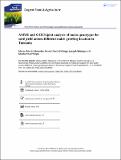| dc.description.abstract | Twenty maize genotypes including breeding lines along with improved local released varieties were assessed for grain yield and yield component stability under three different maize growing agro-ecological zones from January to August 2023. A randomized complete block design (RCBD) with three replication was employed. additive main effects and multiplicative interaction (AMMI) and genotype-by-environment interaction (GGE) analysis was utilized to study the genotype and environment (GE) interactions. The combined analysis of variance showed a significant difference (p ≤ 0.001) in grain yield traits between maize genotypes, environments, interactions and IPC components. The average mean grain yield ranged from 3244 to 5103 kg/ha with a grand mean of 4111 kg/ha The maximum and minimum grain yield was 12325.93 kg/ha (G4) and 1159.68 kg/ha (G9) respectively. The biplot results showed genotype G20, G3, G1, G17 and G15 demonstrated consistently high stable grain yield performance. Genotypes G14, G19 and G4 had high yields, but were unstable as they were far from the IPC1 zero line. Multi-trait stability value indicated that the best genotypes in performance for all traits were G5, G17 and G19. AMMI analysis revealed that the environment at Kibaigwa and NM-AIST was the most ideal environment for seed yield traits. Based on the consistently high and stable grain yield performance, along with other superior grain qualities and plant characteristics, genotypes G5 and G17 were selected and recommended to be advanced and released as new commercial maize varieties in Tanzania for wider cultivation by farmers together with G19, a commercially released variety in Tanzania. | en_US |

